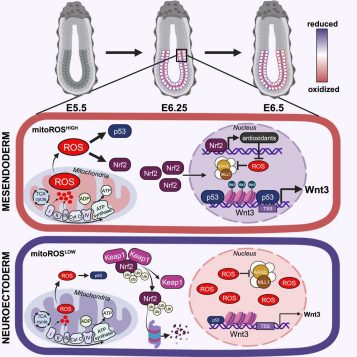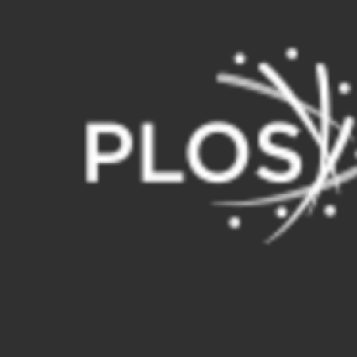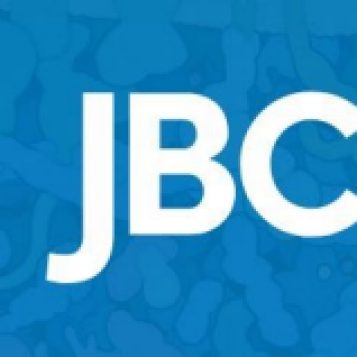- Broad Areas of Research
- Research Themes
- Ask A Biologist
- Recent Publications
-
- Miller Lab: Role of Vinculin in Tricellular Junctions
- Jakob Lab: Embryonic Stem Cell Fate
- Wierzbicki Lab: Membrane association of active genes organizes the chloroplast nucleoid structure
- Shan Lab: Dual phosphorylation of DGK5-mediated PA burst regulates ROS in plant immunity
- Simmons Lab: Bacillus subtilis encodes a discrete flap endonuclease that cleaves RNA-DNA hybrids
- DeSantis/Nandakumar Labs: KASH5 protein
- Cadigan Lab: SOX9 and TCF transcription factors associate to mediate Wnt/β-catenin target gene activation in colorectal cancer
Redox heterogeneity in mouse embryonic stem cells individualizes cell fate decisions
Agnes Ulfig, Ursula Jakob
Pluripotent embryonic stem cells (ESCs) can develop into any cell type in the body. Yet, the regulatory mechanisms that govern cell fate decisions during embryogenesis remain largely unknown. We now demonstrate that mouse ESCs (mESCs) display large natural variations in mitochondrial reactive oxygen species (mitoROS) levels that individualize their nuclear redox state, H3K4me3 landscape, and cell fate. While mESCs with high mitoROS levels (mitoROSHIGH) differentiate toward mesendoderm and form the primitive streak during gastrulation, mESCs, which generate less ROS, ...
See MoreMembrane association of active genes organizes the chloroplast nucleoid structure
V. Miguel Palomar , Yoonjin Cho , Sho Fujii, M. Hafiz Rothi , Sarah Jaksich, Ji-Hee Min , Adriana N. Schlachter, Joyful Wang, Zhengde Liu, and Andrzej T. Wierzbicki
Long and complex molecules of DNA are precisely organized within cells to support genome maintenance and gene expression. In addition to prokaryotic cells and eukaryotic nuclei, this principle also applies to organelles of endosymbiotic origin, which originated from bacterial ancestors and retain their own genomes. One type of endosymbiotic organelle is the chloroplast, which is present in plant and algal cells and is responsible for photosynthesis. We show that chloroplast DNA is organized by binding to membranes present inside the organelle. We propose that transcription...
See MoreSimmons Lab: Bacillus subtilis encodes a discrete flap endonuclease that cleaves RNA-DNA hybrids
Frances Caroline Crowder, Lyle S. Simmons
Abstract
The current model for Okazaki fragment maturation in bacteria invokes RNA cleavage by RNase H, followed by strand displacement synthesis and 5′ RNA flap removal by DNA polymerase I (Pol I). RNA removal by Pol I is thought to occur through the 5′-3′ flap endo/exonuclease (FEN) domain, located in the N-terminus of the protein. In addition to Pol I, many bacteria encode a second, Pol I-independent FEN. The contribution of Pol I and Pol I-independent FENs to DNA replication and genome stability remains...
See MoreCadigan Lab: SOX9 and TCF transcription factors associate to mediate Wnt/β-catenin target gene activation in colorectal cancer
Aravinda-Bharathi Ramakrishnan, Peter E. Burby, Kavya Adiga, Ken M. Cadigan
Abstract: Activation of the Wnt/β-catenin pathway regulates gene expression by promoting the formation of a β-catenin–T-cell factor (TCF) complex on target enhancers. In addition to TCFs, other transcription factors interact with the Wnt/β-catenin pathway at different levels to produce tissue-specific patterns of Wnt target gene expression. The transcription factor SOX9 potently represses many Wnt target genes by downregulating β-catenin protein levels. Here, we find using colony formation and cell growth assays that SOX9 surprisingly promotes the proliferation of Wnt-driven...
See MoreDeSantis/Nandakumar Labs: The KASH5 protein involved in meiotic chromosomal movements is a novel dynein activating adaptor
Ritvija Agrawal, John P Gillies, Juliana L Zang, Jingjing Zhang, Sharon R Garrott, Hiroki Shibuya, Jayakrishnan Nandakumar, Morgan E DeSantis
Dynein harnesses ATP hydrolysis to move cargo on microtubules in multiple biological contexts. Dynein meets a unique challenge in meiosis by moving chromosomes tethered to the nuclear envelope to facilitate homolog pairing essential for gametogenesis. Though processive dynein motility requires binding to an activating adaptor, the identity of the activating adaptor required for dynein to move meiotic chromosomes is unknown. We show that the meiosis-specific nuclear-envelope protein KASH5 is a dynein activating adaptor: KASH5 directly binds dynein using a mechanism conserved...
See More





